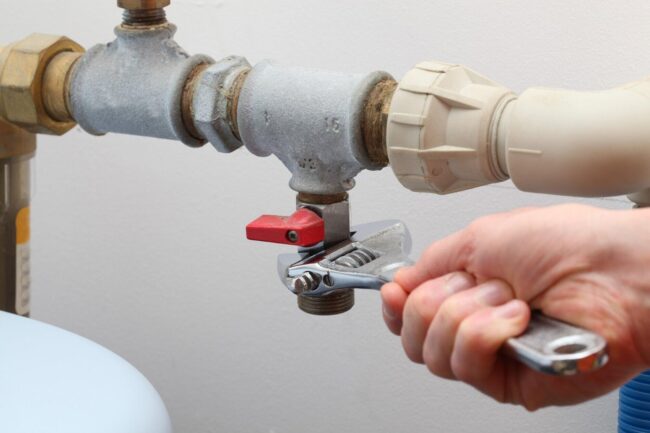
Few things are more frustrating than flushing the toilet and seeing the water rise instead of draining. It’s frustrating, messy, and often comes with a sense of urgency, especially if you only have one bathroom in your home. But don’t panic! A clogged toilet is one of those common household issues that can be easily managed if you know the right steps to take. Before you call a licensed plumber for assistance, let’s walk through a few methods you can use to try to get your toilet draining properly again. Using the proper tools and methods, you may be able to skip the plumbing bill entirely!
1. CHECK FOR OBVIOUS BLOCKAGES
The first thing you’ll want to do is inspect the toilet to see if there’s any visible blockage near the rim or drain. Sometimes, simple objects like toilet paper, wipes, or even small toys can block the passage. If you can see the blockage and it’s reachable, you can grab a pair of tongs or a gloved hand to remove the object.
But before you proceed with any of the methods below, make sure to stop the water from overflowing. If you notice the water rising too high, quickly lift the toilet tank lid and close the toilet’s flapper valve. This will stop additional water from entering the bowl and worsening the mess.
2. TRY A PLUNGER
A plunger is a dependable tool for unclogging a toilet, but not all types work effectively. Be sure to use a flange plunger, as it’s specifically made for toilets. It has a rubber flap that extends from the bell-shaped cup, helping to create a tight seal within the toilet’s drain.
Here’s the proper way to use it:
- Place the plunger into the toilet bowl.
- Press down gently at first to remove any air, then push and pull with steady force.
- Continue this process for 15–20 seconds.
- Then, flush the toilet to see if the blockage is gone.
If the water drains, great! If not, you can try plunging again a few more times before moving on to another method.
3. TRY A TOILET AUGER (PLUMBING SNAKE)
If the plunger doesn’t seem to do the trick, a toilet auger might be your best friend. A toilet auger is a specialized plumbing tool used to clear or retrieve clogs that are deeper in the drain. You can find one at most hardware stores for a reasonable price.
To use a toilet auger:
- Insert it into the toilet bowl and gently guide it into the drain.
- Rotate the handle to push the coil deeper into the pipe.
- If you encounter a blockage, keep turning to either dislodge the clog or grab onto it.
- Once you feel resistance or the auger is no longer moving easily, slowly retract it.
- Flush the toilet to see if the water drains properly.
A toilet auger is a great tool to have if you often deal with stubborn clogs. If you’re uncertain about how to use it, feel free to contact a licensed plumber for guidance or help.
4. BAKING SODA AND VINEGAR
For an environmentally friendly solution, consider using the baking soda and vinegar method. This DIY solution works wonders by helping to break down the materials causing the clog, and it’s safe for your pipes and the environment!
To try this method:
- Begin by adding approximately one cup of baking soda to the toilet bowl.
- Next, pour in two cups of vinegar and let the mixture fizz.
- Allow it to sit for 20–30 minutes so the bubbling effect can work on breaking down the clog.
- Finally, flush the toilet to check if the water drains properly.
This method is great for minor clogs caused by organic materials, but if the clog is more serious, you may need to try another solution.
5. DISH SOAP AND HOT WATER
Another simple DIY method is using dish soap and hot water. The soap helps lubricate the drain, while the hot water softens and loosens the clog.
Here’s how to do it:
- Pour a generous amount of dish soap into the toilet bowl.
- Heat up a pot of water, but be careful not to overboil it to prevent damaging the toilet.
- Slowly pour the hot water into the bowl from about waist level.
- This will create pressure and might help move the clog through the drain.
- Allow the soap and water to sit for 10–15 minutes before flushing.
This technique can be highly effective for clearing minor clogs caused by toilet paper or soap buildup.
6. CALL A LICENSED PLUMBER
If nothing works and the toilet remains clogged, it might be best to contact a professional. A Licensed Plumber will have the knowledge, experience, and tools necessary to assess the situation and solve the problem efficiently. Sometimes, the issue could be related to deeper plumbing problems, such as a blockage further down the pipes, tree roots invading your sewer lines, or a problem with the toilet’s internal components.
A Licensed Plumber can diagnose the cause of the clog and provide you with the best solution so you don’t have to worry about future issues.
CONCLUSION
While clogged toilets can be frustrating, they don’t have to cause major problems. With the right tools and a little bit of patience, you can often clear the blockage yourself. Remember, if the clog persists or if you’re dealing with something more complicated, it’s always a good idea to get in touch with a Licensed Plumber. They will help you save time and keep your plumbing system in excellent condition.
Whether you’re plunging, using an auger, or trying out the baking soda and vinegar trick, don’t be afraid to tackle your toilet troubles head-on. If you require assistance, a Licensed Plumber is only a call away!
